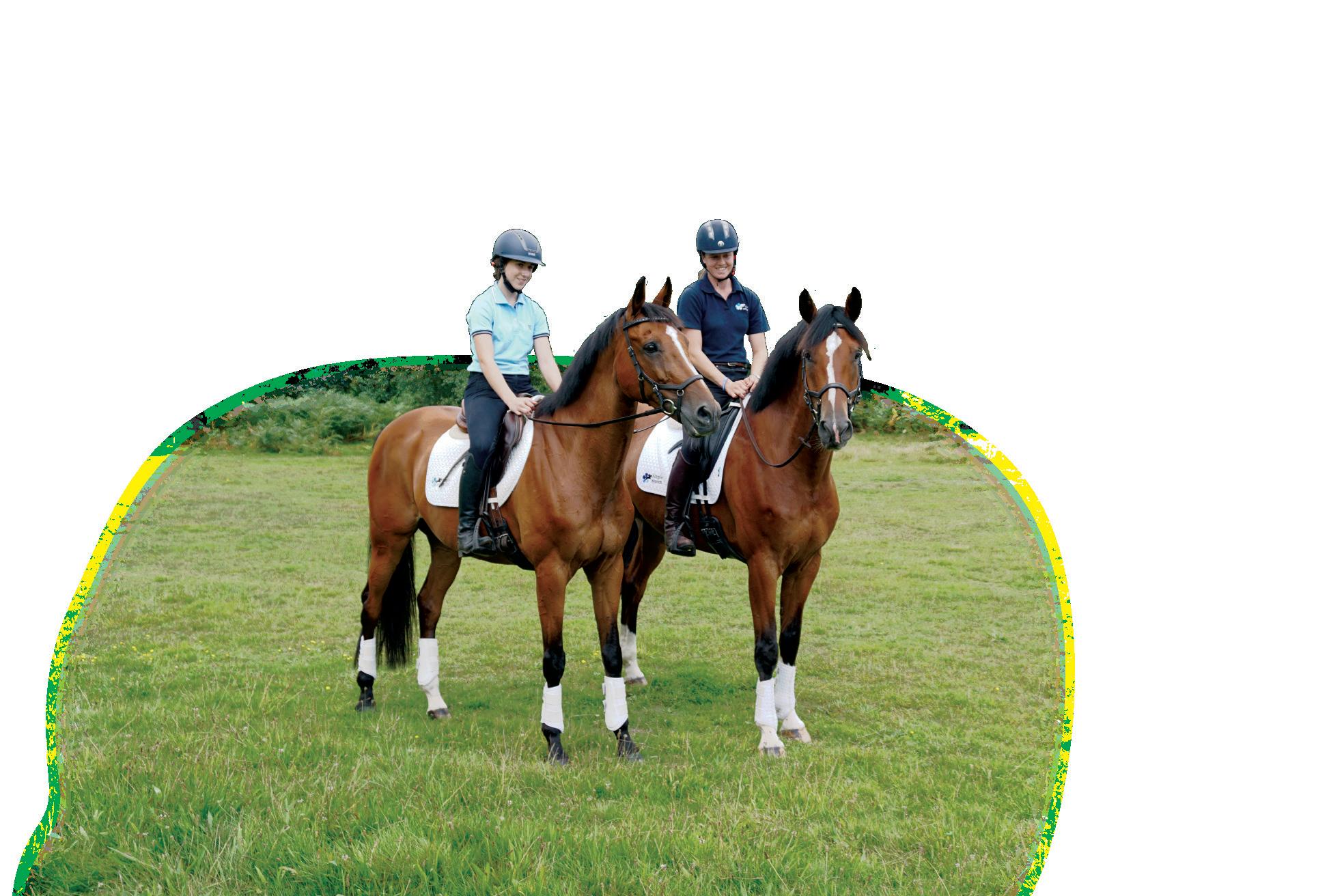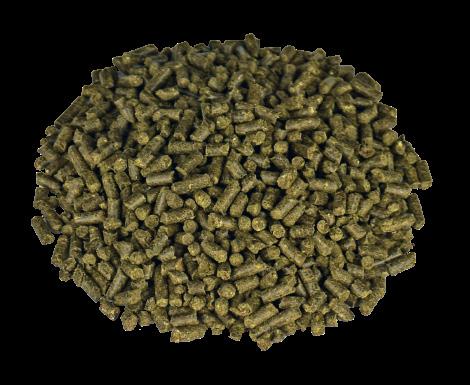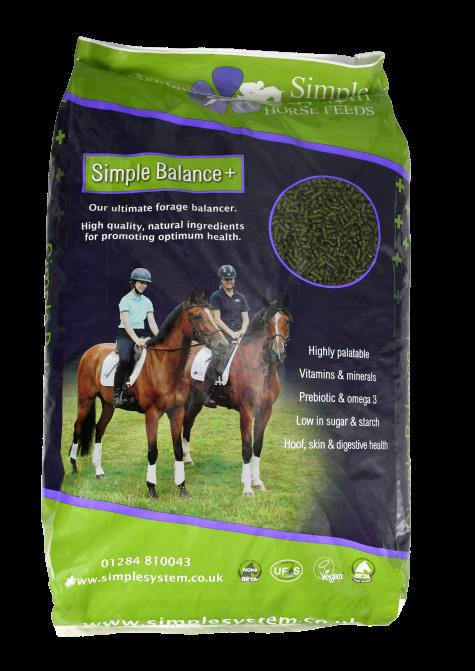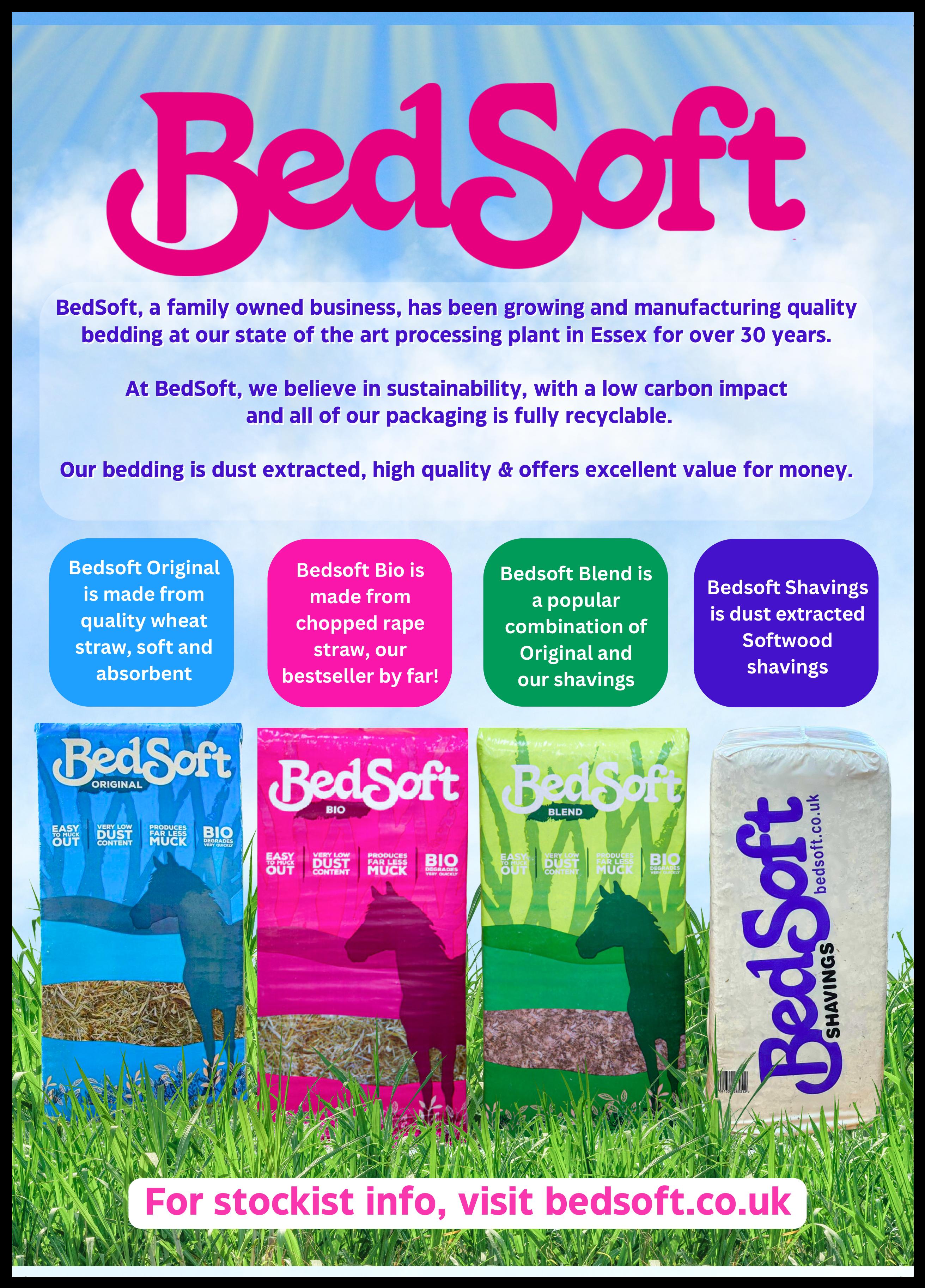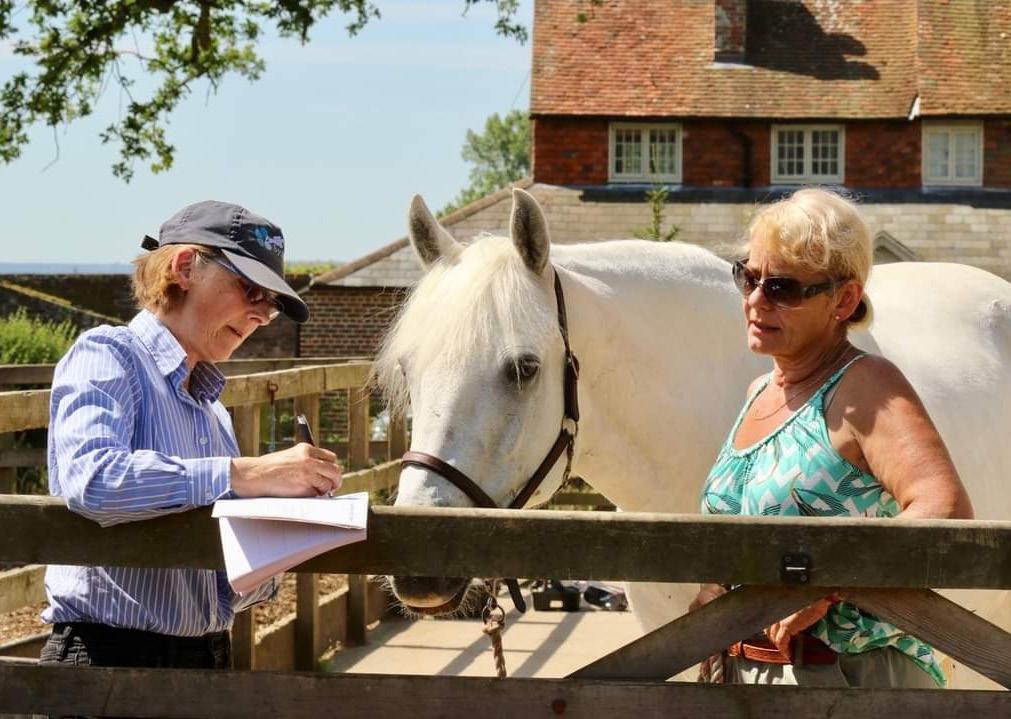Digestive Health
Diversity

Pasture




HORSE FEEDS
Issue 9
Spring / Summer 2024
Contact Us
Simple System Horse Feeds, Symonds Farm, Newmarket Road, Risby, Bury St Edmunds, Suffolk IP28 6RE 01284 810 043 sales@simplesystem.co.uk www.simplesystem.co.uk
Feed Advice
01728 604 008 info@simplesystem.co.uk
Cover photo | Junior owned by Simple System customer, Georgia Gardener
Photo credit | Front coverColeraine Capture. Right hand page - Tilly Emeline
About Simple System
Simple System Horse Feeds is an independent, family owned feed company based in rural Suffolk. The company was founded in 1996 with the aim of producing natural and nutritious feeds that horses were designed to eat. The entire range is free from cereals, molasses, pulses, straw, soya, preservatives and additives.
What a season we have ahead! Paris 2024 is set to inspire us all when it puts equestrianism at the centre of the world stage this August. Budding Olympic hopefuls pay attention to our Target Feeding article on page 18 - it’s a great way to help maximise the performance of our equine partners.
Aside from Paris, we’d been very much looking forward to Badmintonespecially the Grassroots Championships where supported rider, Martin Wright and homebred Mednight Lane (AKA Rodney) have been flying the Simple System flag. They’ve had an incredible season so far and are certainly ones to watch this spring and summer.
Closer to home we’ve been busy preparing to launch a unique new feeda blend of valuable forages
Page 4 : News & Updates
Page 6 : Diversity
Page 8 : Laminitis: Your Questions Answered
Page 10 : Promoting Nature-Friendly Fields
Page 12 : Dung, an Indicator of Digestive Health?
that have been growing together in our farmer’s fields. Keep an eye on our socials for more details.
This new feed, Meadow Forage Pellets, has inspired a number of the articles in this issue - from diversity (page 6), to promoting nature-friendly fields (page 10) and even through to taking a closer look at our horse’s dung (page 12).
This issue of The Scoop was actually branded ‘The Poop’ at Simple System HQ. Either my editing skills are poop, or poop has wormed its way into a number of our articles. I’ll allow you to form your own opinions there. Enjoy! Melody Ashcroft

Page 16 : Equine Faecal Water Syndrome
Page 22 : Does my Horse Need a Hay Replacer?
Page 24: Horse Pasture - An Environmental Opportunity
Page 26: Customer Feature - Becoming a First-Time Breeder
Page 28: Feed Room Fun
Page 29 : WIN!!! a 3 month supply of feed & bedding
Junior wasn’t the kind of horse para-rider Georgia Gardener was looking for. He was too big, the wrong type, rough looking and scraggly around the edges - the only part that ticked any boxes was that he was a gelding! Fast forward nine years and this partnership has been through a great deal together, from chronic pain and a life-changing diagnosis of HEDS for Georgia to building a strong competitive partnership - Junior is the project horse that never left! Follow their incredible adventures on Instagram @bandmastertales.
21 year old Junior is fed a Simple System diet of Build & Shine, Red Bag Grass Pellets and Perform & Shine. Georgia has also recently added Veteran Balance + to the diet to offer joint support. Junior’s field mate, Spud (also pictured below) has a diet of Build & Shine, Blue Bag Grass Pellets and HayCare.
Junior’s Simple System diet includes grass and lucerne chops for variety and performance

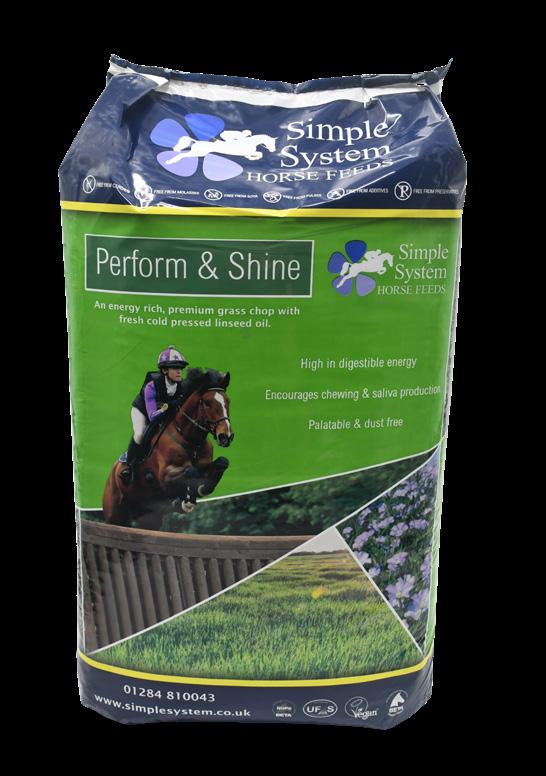





Lucie®Chop is exactly the same pure ‘GreenGold’ lucerne chop that your horses know and lovejust with a new name and a new, larger 18kg bag.
The bigger bag means less plastic and better value - saving an equivalent of £1.80 per bag!

Received fantastic advice from our Feed Line or found our advice articles helpful? Please consider nominating us for the ‘Nutritional Helpline of the Year Award’. It takes just a moment and would mean the world to our team. Thank you.
Scan the code to nominate us


Save the date - we’d love you to join us.
Cheshire Polo Festival. A family-friendly day for all to enjoy. Visit us at the Horse, Hound & Hunter stand where we will have free samples and exclusive discounts. When? 20th July
Where? Cheshire Polo Club, Tarporley, CW6 9ES
Entry £10 per car - details available at www.cheshirepoloclub.com
BEVA (British Equestrian Veterinary Association) Congress. We are delighted to be exhibiting for equine veterinary professionals at congress again this year. Our experts will be on hand to chat about feeding forage and we’ll have our HayCare Care Packs available. When? 11th - 14th September
Where? ACC, Liverpool, L3 4PF
Tickets and details at www.bevacongress.org
Your Horse Live. Join us at our favourite event of the year! We’ll be offering expert feeding advice, exclusive discounts, competitions and you may even meet a Dinky Pony or two!
When? 8th - 10th November
Where? NEAC Stoneleigh, CV8 2LZ
Tickets and info at www.yourhorselive.co.uk
We are delighted to welcome the Dinky Ponies and their human, Sarah (pictured to the left) to the Simple System ‘Supported Rider’ family. It was when working as a freelance groom for top rider Sir Mark Todd, that Sarah’s Dinky journey began - she had spotted two miniature Shetlands in a neighbouring field, found out who they belonged to and started to help with their care. Sarah grew to know and love the ponies and their owner allowed her to take them on. A few months later Sarah was offered two more ponies and before long she had 6! Sarah knew they were all individually very special and she wanted to share them with others - in 2022 Dinky Ponies was born! Initially the Dinkys worked with young children, but before long they began to visit care homes, hospitals and hospices - spreading joy and providing enrichment wherever their little hooves went.
In order to do their jobs well the Dinkys need to be happy and settled in their work. The Dinkys are exclusively fed a Simple System diet of Lucie®Nuts, Veteran Balance + and Instant Linseed One Dinky, Gracie, is also supported with Lunar Eclipse.
The Dinkys have become a social media sensation by sharing heartwarming videos of their therapy visits. Follow them on Instagram or Facebook @dinkyponies.
Our store coverage has grown significantly in the last few months. Here are just a handful of our new stockists;
• Rollins Farm Supplies | Cambs, PE28
• Horse & Hen | Derbyshire, DE4
• Equine Supplies Essex | Essex, CO7
• LCP Animal Feed & Pet Supplies | Loch Lomond, G83
• Happy Horse Equestrian Supplies | Suffolk, IP12
• Sales of Sandon | Hertfordshire, SG9
• Equitogs | West Sussex, RH14
To find your closest retailer head to www.simplesystem.co.uk, click ‘Stockists’ at the top of the page and enter your postcode.
Look out for Meadow Forage Pellets online and in store this spring / summer season.
This exciting new feed is a blend of valuable forages grown together to increase variety in the diet - ideal for supporting beneficial gut microbes, as well as for providing enrichment. Keep an eye on our social media pages or visit www.simplesystem.co.uk for further details.
We felt that it was about time our favourite feed for travelling and stay-away shows , Simply Complete, received a well-deserved re-vamp.
Whilst the feed inside the bag remains the same with zero formulation changes, the packaging has had a much improved look featuring supported rider, Martin Wright and his very handsome horse, Rodney.
Martin & Rodney feature on our new SimplyComplete bag
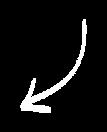
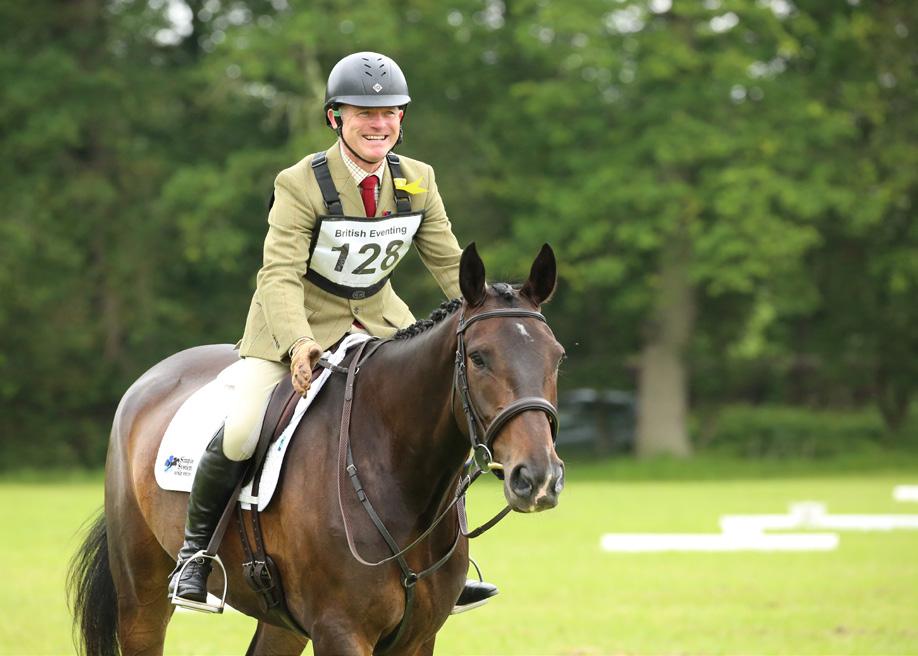
Build & Shine - our lucerne chop with fresh, cold-pressed linseed oil is now in a larger 18kg bag. This saves on the packaging and transportation costs - meaning we can pass the savings to our customers.
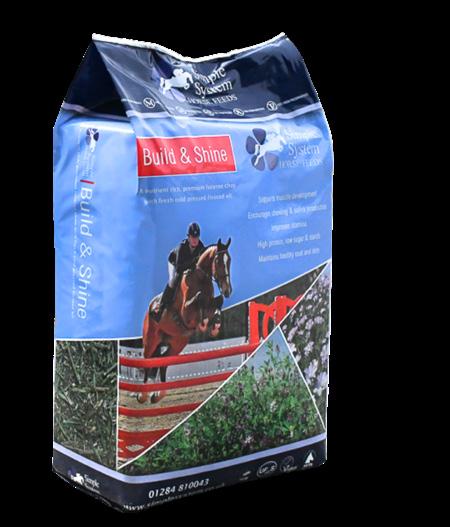
The new 18kg bag price is £20.50 - an equivalent saving of £1.62 per bag!
Follow us for more updates


 van Lennep BSc., MSc., BHSI(SM)., NPSD | Director of Nutrition |
van Lennep BSc., MSc., BHSI(SM)., NPSD | Director of Nutrition |

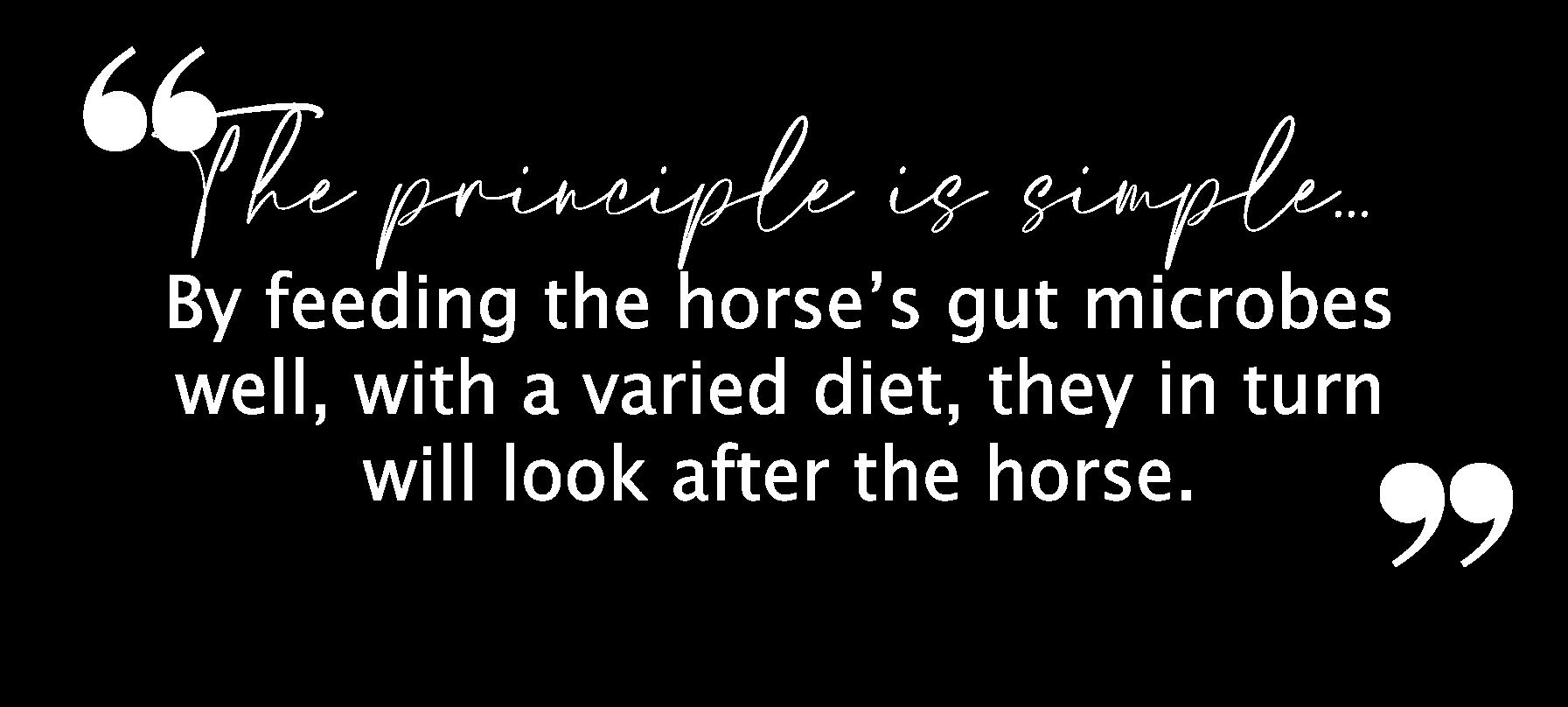
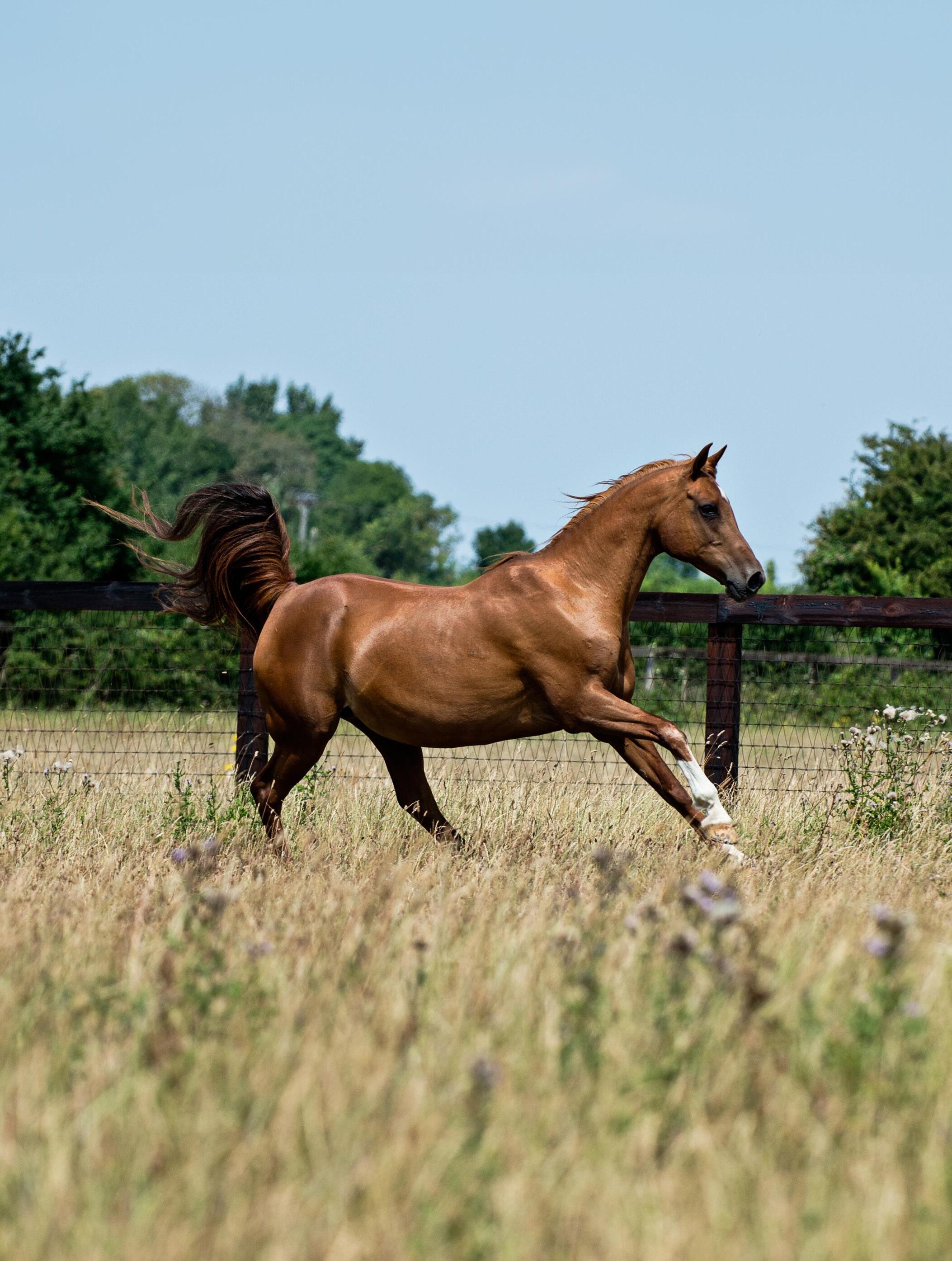
It is said that variety is the spice of life and certainly the more we look, the more evidence we find that diversity and variety is good in all sorts of ways.
Horses evolved on a very diverse diet, with a wide range of grasses, legumes, forbs and herbs available, not to mention shrubs and small trees to browse on as the need arose. Their natural diet varied from season to season and even day to day. Choice they had aplenty! Once we came along and the grazing and hay became predominantly ryegrass and the “short” feed the processed by-products of the human food industry, it must all have seemed pretty poor by comparison. Taped off paddocks with no access to hedges and overgrazed grass is a very limited substitute for plains abundant with diverse plant forms. At Simple System, we do our best to address the lack of diversity that many horses have to endure. Variety is not only enriching for our horses but also vital for their gut microbes, which have evolved to thrive on a wide range of forages and are negatively impacted by unnatural feeds.
Diversity in your horse’s feed can be addressed by varying the forages fed. Different types of grass, such as fescue, Timothy and cocksfoot for instance; legumes such as sainfoin and Birdsfoot trefoil.
Improving diversity in the field is beneficial for horses and for wildlife. Here are a few ideas...
Fence off a strip and allow it to go to seed, spreading the range of wildflowers. Top up bare areas with a mix of suitable wildflower seeds or a hay cropping mix specifically for horse pasture like our Natural Grazing Mix. Allow a bit of wildness to establish in a fenced off corner. You may even be in a position to establish some hedging on your own land - the wild dog rose (Rosa canina) can be a great option as their rosehips provide natural joint support. For those on livery or renting land, volunteer your help to your yard or field owner to create a more diverse environment for the horses.
Each and every different plant source will support, or diminish, a different range of gut microbes. Processed food will be less supportive than unprocessed. Never underestimate the value of good hay, but be very aware of the damage poor hay can do, not just to the lungs with dust and fungal spores causing coughing and even permanent lung disease, but toxins from mould can damage the liver, making the horse chronically unwell. Eating very dry food in the confines of a stable is a long way from their natural state.
Offering the best helps ensure our horses are given the greatest chance of a healthy life. By feeding the horse’s gut microbes well, with a varied diet, they in turn will look after the horse.
If you’d like to add more variety to your horse’s diet, our nutrition team will be happy to help. Contact the Feed Line on 01728 604 008 or by email to info@simplesystem.co.uk.
Created to support a wide range of beneficial gut microbes. Increases variety in the diet
Highly palatable & easily digestible Chosen specifically for horses
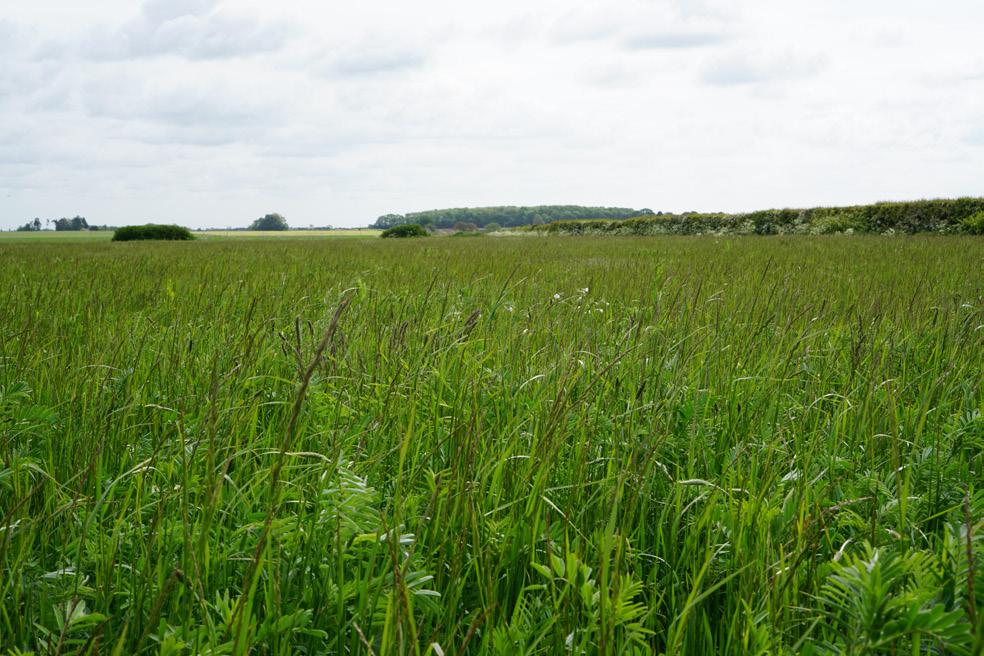
There are many common misconceptions about what causes laminitis and how it ought to be managed. Simple System Director of Nutrition, Jane van Lennep, answers some of the questions that are frequently asked by customers who contact our Feed Line.
I’ve heard that short grass is not actually the best for laminitic horses. Why?
It seems logical that if there is less grass, that has to be better than lots of grass for laminitis prone equines, but short grass is only that way due to being grazed down. The grass wants to grow and make seed, so constant grazing stresses it, which in turn increases its sugar levels. High sugar levels should be avoided for those prone to laminitis. Sugars are stored in the base of the plant, so grazing short grass will actually increase the proportion of sugar ingested by the horse.
Grass that has been allowed to grow tall and ideally, go to seed, will have far higher levels of fibre, much less sugar, will not be stressed and will also provide a far more satisfying chew - a much better option for our horses.
Should I ‘starve’ my overweight horse to make them less suceptible/help them recover? In short - no! A high fibre, forage diet is important for gut health. Protein should be sufficient to support muscles.
‘’Alice has been on MetaSlim® for nearly two years now and the results have been fantastic. She has lost a lot of weight and I find it much easier to keep the weight off. She feels a lot more supple in her neck and across her back too”. Sarah Brown
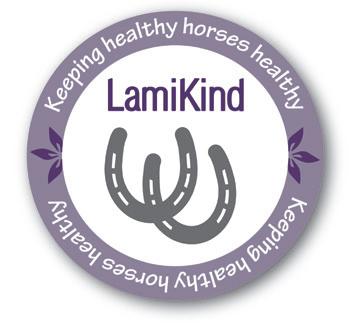
Over-restricted horses very cleverly lower their metabolic rate and hold onto body fat as part of their natural survival mode. This makes weight loss trickier. Providing insufficient volume of food also causes stress which releases associated stress hormones. This actually increases the risk of metabolic issues such as Cushing’s Disease (PPID), Equine Metabolic Syndrome (EMS) and Insulin Dysregulation (IR).
My horse is currently on box rest with laminitis, but I am really upset they are not actually overweight. Why do they have laminitis? Laminitis is a metabolic disorder and many but not all, are overweight when they develop the condition. It is associated with EMS, PPID and IR. Once a horse has suffered a bout of laminitis, it takes less to trigger an episode. Stress can also be involved, so it is important to keep all horses, but especially susceptible ones, stress free. Company, access to enough forage and outside space are all important. Horses with fat pads, such as a cresty neck, are more susceptible, even if the rest is lean.
To discuss feeding your laminitis prone or metabolic horse, call the Simple System Feed Line on 01728 604 008. If your equine friend is showing any symptoms of laminitis please contact your vet in the first instance.

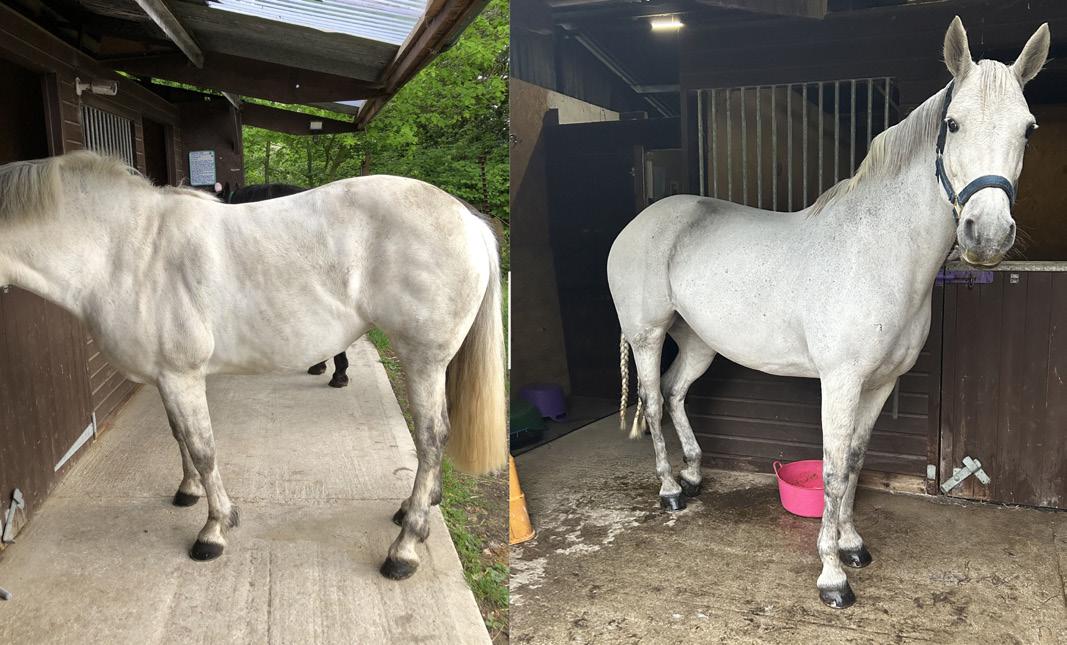
3 A balancing feed, specifically designed for those challenged by weight or metabolic issues
3 Natural plant-based ingredients, free from artificial additives and preservatives
3 Optimises blood sugar levels and aids insulin effectiveness





We share our horse pastures with a lot more than just our horses. Making just a few small changes can make a notable difference to nature - from the smallest of insects to our wonderful mammals.
Here a few simple changes you can make without impacting too much on your horses:
• Fence across the corners. This is safer for the horses as it avoids one getting trapped in the corner. The fenced off area maybe small but you could consider planting a tree or beneficial shrub such as the wild dog rose, or you could just leave it to nature.
• When harrowing and/or topping, leave a patch in the middle – it need not be very big, say 30m square or so – this can develop as refuge for wildlife and for different plants to grow to offer the horse some variety. If you don’t top or harrow, leave a similar patch with the droppings left behind for the dung beetles.
• Introduce different plants to the sward by adding a suitable native wildflower seed mix. Simple System Natural Grazing Mix is specially formulated for horses and ponies and is entirely ryegrass free. As well as native type grasses, it has herbs and legumes that are beneficial for wildlife and for horses. As a pocket-friendly option you could even collect seeds from suitable plants growing locally, such as on verges. Tread these gently into bare areas at the end of the summer.
• Allow hedges to grow a little taller and rather than cut them back every year, do this in alternate years, or cut one side this year and the other side next year.
• Reinforce vulnerable gateways with stone or aggregate to prevent too much poaching. In a year or two plants will establish so you will have less mud and more vegetation.
• If you have hedges, identify a good specimen and allow it to grow on as a tree. Hawthorn, hazel and field maple are all beneficial for nature, palatable for horses and make attractive specimen trees.
• Replace traditional fertilisers, with a natural soil treatment. Simple System Natural Paddock Recovery is ideal for use on acidic horse pasture. It will help restore vital minerals, promote healthier growth and balance pH levels - allowing more species to flourish.
• If you use an electric fence, fence off a strip at the side and allow the plants behind it to grow tall and go to seed, then allow the horses to graze it.
Not everything is appropriate for everyone and you will have some more ideas yourself, but as they say, every little helps and by helping nature we are helping the planet too.
If you’d like to discuss your paddock or your horse’s diet our nutrition team will be happy to help. Contact the Feed Line on 01728 604 008 or by email to info@simplesystem.co.uk.



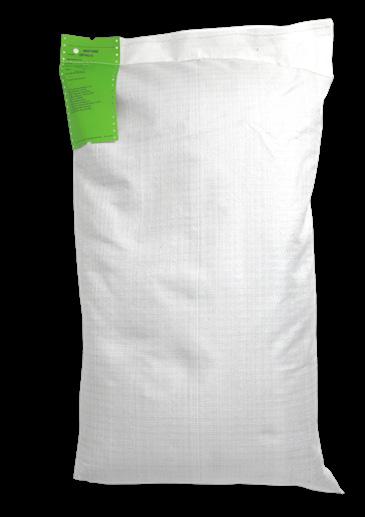


As a feed company we spend a lot of time discussing what goes in the front end but in this article, we are going to discuss what comes out of the other end!
Droppings, assessed on their colour, frequency and consistency, can tell us a lot about a horse’s digestion, health and hydration status and may even be an early indication of things going awry. As with any assessment, it is always worth establishing what is normal for your own horse. There will always be some level of individual variation.
Frequency? The number of droppings passed by your horse should be roughly the same each day. In mares and geldings this is cited as 8-12 droppings in 24 hours, but I think we all know in practice it can be much higheror certainly seems so when we are pushing the wheelbarrow through a muddy field! Foals, stallions and nervous horses may pass droppings much more frequently.
A sudden decrease in dropping frequency may suggest a decrease in feed intake or, that things aren’t passing through the digestive tract as they should which may be an early indicator of impaction colic. Passing droppings much more frequently may be “normal” in anticipation of an exciting event or can be an indicator of stress.
Consistency? A key indicator of digestive health is the consistency of the droppings passed. Normal droppings should appear softly formed into faecal balls that just come apart on landing; they usually have a glossy appearance.
Horses kept on a more fibrous, predominantly hay diet may have firmer, drier looking and more visibly formed droppings which would be quite normal based on their management.
If the droppings are very hard and pebbly this may indicate dehydration or a diet high in very indigestible fibre or poor-quality forage.
In the other direction, soft unformed droppings, very loose in consistency may indicate a diet low in fibre or predominantly grass based as grass has a naturally high water content. Some horses may also pass loose droppings as a sign of mental stress before travelling or due to digestive stress in response to feed changes.
Diarrhoea can vary in severity and may have an innocent cause such as moving onto richer spring grazing but very liquid and watery droppings are always a cause for concern - especially with a sudden onset - and you should seek advice from your vet. Watery droppings may indicate sand colic, infection or the presence of parasites.
Faecal Water Syndrome is a separate topic entirely (discussed on pages 16 & 17), as it refers to the passing of excess liquid at the same time or independently of defecation and the droppings themselves can be normally formed.
Colour? Normal droppings from a healthy horse are typically a brown-green colour and this will vary by the diet they are fed; those fed mostly hay will have much browner droppings and those on lusher pasture can have almost luminous green droppings!
Droppings will darken when they dry out, but very dark brown, almost black droppings may indicate poor quality, low nutrition forage.
In very severe cases of ulcers or illness, black-red droppings may indicate intestinal bleeding. Any visible blood is a serious cause for concern and your vet should be contacted immediately.
Some medications can alter the colour of droppings whilst a yellow, mucus-like tinge may suggest a high fat or non-structural carbohydrate intake, or difficulty digesting their feed with excessive bile production.
Other things to look out for? Odour is an important consideration and whilst horse manure isn’t the most pleasant smell (depending on who you ask!) it shouldn’t be overpowering and unpleasant like poop from carnivores can be! Any droppings that are unusually strong or foul smelling may indicate hindgut disturbances or digestive upset.
Many of us will have had to do a ‘sand-test’ at some point. This is most commonly done by mixing fresh droppings with water in a glove or clear plastic bag - as sand is heavier than digested fibre it will sink to the bottom. It isn’t an entirely conclusive test: a lack of visible sand doesn’t mean your horse isn’t ingesting sand as the amount visible doesn’t accurately tell us how much may be lying in the lower portions of the gut. In extreme cases of sand ingestion, the sand may even be visible in the droppings. A positive sand test or sand in droppings should be taken seriously and discussed with your vet.
From a dietary perspective, Instant Linseed and PuraBeet can help aid the passage of feed and sand through the gut.



The last topic to discuss, one that can make us all a little squeamish, is the visible appearance of parasites in the droppings. Worm eggs are not visible to the naked eye, but faecal worm egg counts are recommended as part of routine management - although they cannot test for all types of worms.
After using anthelmintics, parasites may become visible in the droppings which is “normal” but parasites that appear at any other time should be discussed with your vet. Not seeing worms does not mean your horse is clear from them!
Whilst not as conclusive as a scan, scope or rectal may be, looking at our horses dung is a much more accessible method of assessing their digestive health and something we should all work in to our daily checks. Knowing what is normal for your horse may mean you catch any potential problems before they escalate into more serious health conditions.
If you have any questions about your horse’s poop or the feeds and forages that go into producing it, please let us know!
You can contact the Feed Line by phone on 01728 604 008 or by sending an email to info@simplesystem.co.uk.
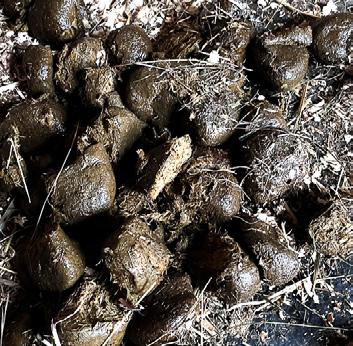
Does your horse have healthy droppings? Email a photo to our Feed Line info@simplesystem.co.uk Soft, poorly formed droppings can suggest insufficient fibre intake Healthy droppings Can you spot the parasite?

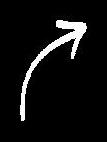

100% Timothy grass grown to a strict nutritional profile





At Simple System we think grass can be great for all horses, but before those with laminitisprone horses close the pages on mass, let’s clear up some common misconceptions.
All grass is the same. No, no, no it isn’t! Whether the grass is in the paddock, or from a feed bag, it can vary greatly. Nutrition levels differ from season to season and even from night to day.
Spring grass is the most nutritious. It has the highest energy levels (calories) and in a typical growing season has good levels of protein. It’s nature’s way of helping horses recover from weight loss they would have endured in the winter. It also provides well for mares, their nursing foals and stallions, who all require additional calories during the breeding season.
Red Bag Grass Pellets are essentially like spring grazing in a bag. They are high in useful, digestible energy. This makes them an excellent choice for hard working competition and racehorses, as well as for breeding stock and their offspring.
Summer grazing is also nutritious, but it is less calorie dense than spring grass. It is lower in sugar, low in starch and is more fibrous. Blue Bag Grass Pellets offer the equivalent of summer grazing and are ideal for light and medium work and for improving / maintaining condition. They suit almost all horses and are a year round best-seller.
Mature grass that has been allowed to grow to the ‘hay stage’ is typically very high in fibre, low in sugar and low in starch making it a far better option for those prone to weight gain and laminitis.

HayCare® and Timothy Chop are both 100% mature cut Timothy grass - both are suitable for good doers and metabolic horses.
Short, stressed or continually grazed grass has a high sugar to fibre ratio. This is why we should try to avoid turning out laminitis-prone horses on such pasture. Long grass is generally a far better and far safer option.
HayCare®, although most commonly used as a hay replacer for those who struggle to chew hay, can be fed to provide bulk before turnout. This can be a great solution for good doers who would normally gorge on short, sugary grass. As HayCare® is fed soaked there is also the added benefit of being able to provide hydration. Very useful in the warmer months! Another option is to place piles of hay out in the paddock. Spreading the piles into different locations encourages natural foraging behaviours and movement - ideal for those whose weight needs managing.
Still unsure which to choose? Our Feed Line will be happy to help, call 01728 604 008 or email info@simplesystem.co.uk
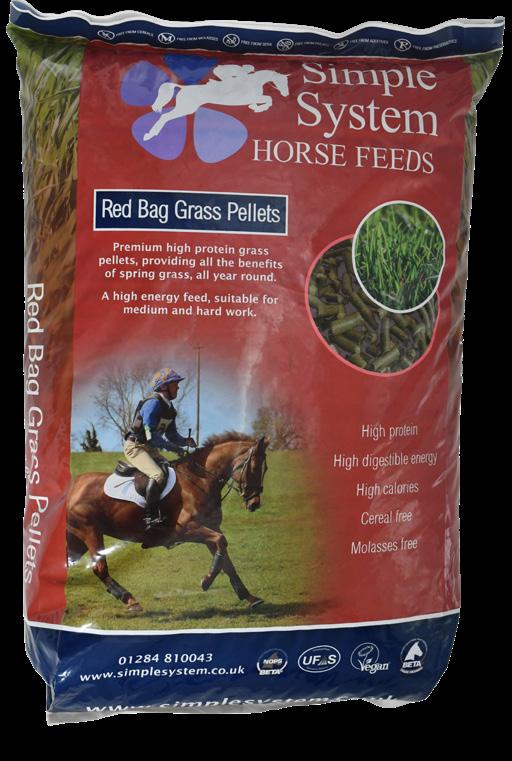

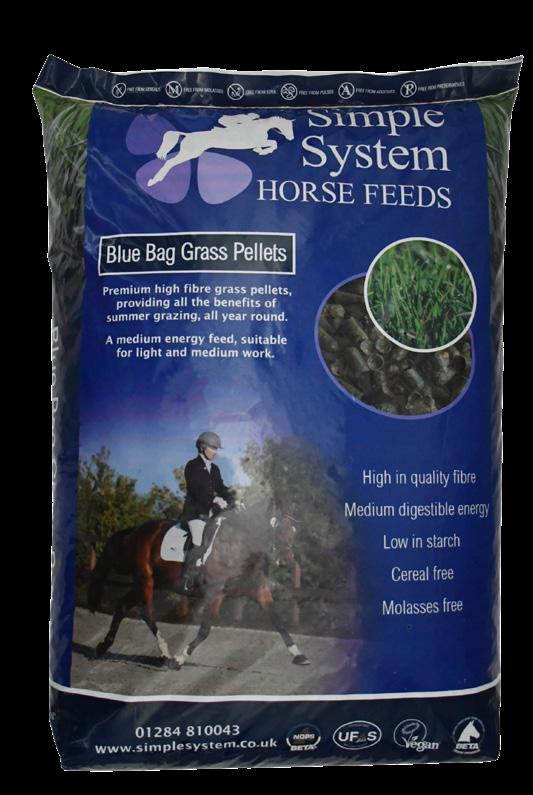


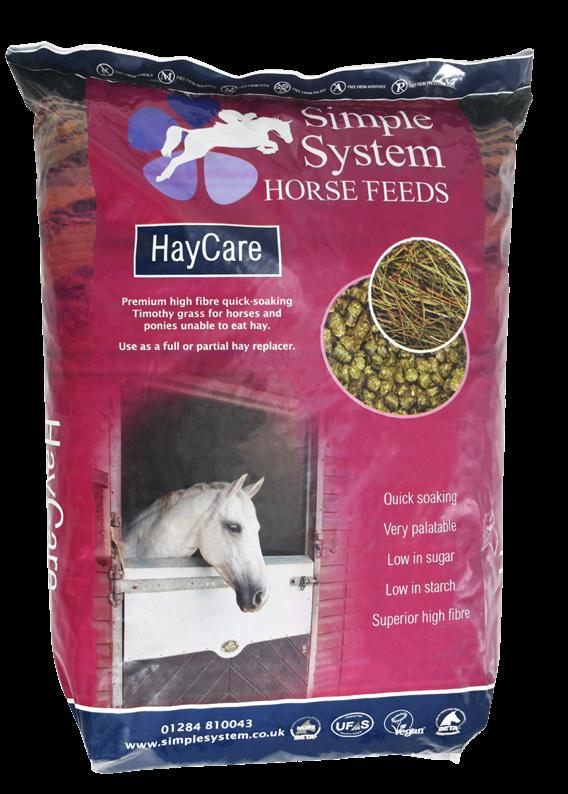

What is Equine Faecal Water Syndrome?
Faecal Water Syndrome (FWS) refers to the passing of excess free liquid before, during or after the passing of droppings. It can also happen independently of defecation, where no physical droppings are passed. The droppings themselves may appear quite normally formed or may also be quite loose. In some horses, the issue is persistent whilst in others it can be seasonal or sporadic and entirely random.
It is unfortunately common that FWS results in horses having dirty tails and hindlegs that require frequent grooming and washing. In the warmer months, the issue may subsequently attract flies. In severe cases or with sensitive horses, it can lead to irritation and dermatitis on the hindlegs and buttocks, whilst some start to object behaviourally to being washed so often. In mares there is the increased risk of contamination to the vulva, leading to infection or reduced fertility in breeding stock.
What causes Faecal Water Syndrome? The exact cause of FWS can often be hard to determine but it generally indicates that something somewhere is irritating the digestive tract, or it is simply not working correctly. In older horses it can be a result of reduced fibre intake when they are no longer able to manage long stem forages like hay.
Fibre has an excellent water carrying capacity but insufficient chewing of hay, or simply an insufficient fibre intake, will reduce this capacity, requiring excess water to be expelled separately - only so much fluid can be filtered out and expelled via urination.
Some very coarse hays with a high indigestible fibre content, akin to straw, can also have the same effect as they do not carry water effectively.
Typically, horses on a forage based diet may be at lower risk of developing Faecal Water Syndrome but ryegrass-based forages and haylage can also be triggers, especially as the latter can be quite acidic due to the fermentation process.
In some cases, the trigger may be a more serious underlying health condition such as Inflammatory Bowel Disease or Hindgut Acidosis.
How do you treat a horse with Faecal Water Syndrome? With these horses it is always best to try and establish the route cause as without doing so, any amount of intervention or treatment may fail.
For older horses it can be a simple case of swapping their forage for an easier to chew alternative such as HayCare® or for younger horses, swapping to hay over haylage. It is also essential to avoid any long gaps without forage as this can lower pH levels throughout the digestive tract and cause irritation.
Any feeds containing unsuitable and potentially irritating ingredients should be removed with a focus on increasing forage variety in the diet. Feeding a more varied forage diet is known to support a more diverse range of hindgut microbes - beneficial for digestion and immune response.
Encourage the grazing of hedgerows and verges where free from poisonous plants and overseed with a diverse (ryegrass-free) seed mix to produce more variety in the paddock.
You can also use a different forage type for your chop and pellet feed, making use of acid buffering, low sugar lucerne where possible. Organic feeds further ensure minimal exposure to irritatating chemicals. Sainfoin is very useful to support the hindgut microbes thanks to its condensed tannin levels.
PuraBeet and Instant Linseed may offer soothing support; beet-pulp is high in soluble fibre which adds bulk to the diet and is highly digestible to avoid over-working a stressed digestive tract. Linseed forms a mucilage-like gel when digested, to physically coat the lining of the digestive tract and its anti-inflammatory properties can promote healing. Both these also aid the passage of feed.
Eclipse Recovery is rich in the metabolites of fermentation to support gut function, fibre digestion and immune response.
Horses with FWS are also at risk of losing dissolved salts and becoming dehydrated. It is important to provide free access to a plain salt source or consider adding Summer Salt to their feed or water to aid rehydration. Alternatively place a Salt Lick Tub in the stable or out in the field. Make sure that plain, unsalted water is also always freely available, and that they are drinking adequately.
If the condition persists or worsens despite changes to management and feeding, or you become concerned for your horse’s health and welfare, it is always wise to consult with your vet.
For a free Feed Plan tailored to your horse’s individual requirements please contact our equine nutrition team on 01728 604 008. Alternatively complete our advice request form by scanning the code below.

or find

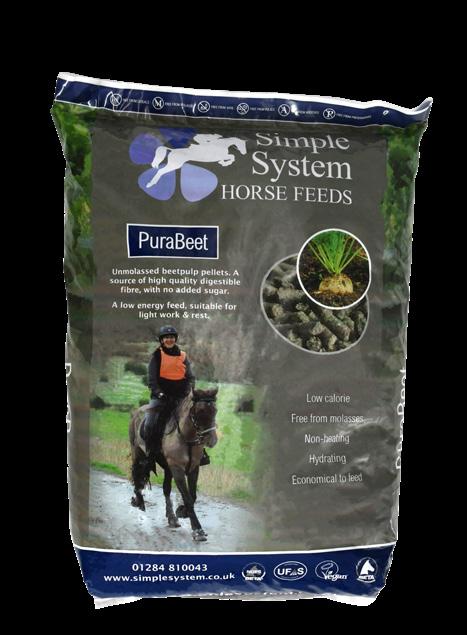
PuraBeet is a source of highly digestible fibre. It’s also a great hydrator - soaking up to 5 times it’s volume of water!
RRP £15 for 20kg

Instant Linseed aids the passage of feed and is a natural antiinflammatory.
RRP £18.50 for 5kg or £45 for 20kg
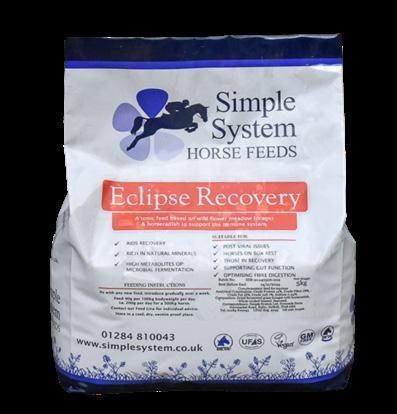

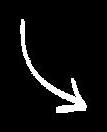
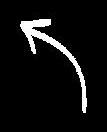

Eclipse Recovery is a natural wildflower tonic feed to support gut function and the immune system.
RRP £33.75 for 5kg or £59.25 for 10kg
Salt should always be available to aid rehydration.
2kg Summer Salt
RRP £8.75
10kg Salt Lick Tubs
RRP £19.95

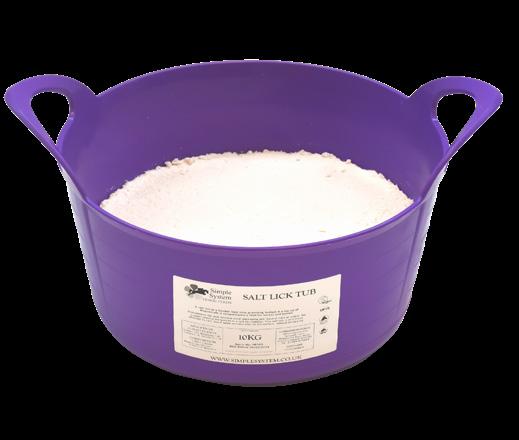
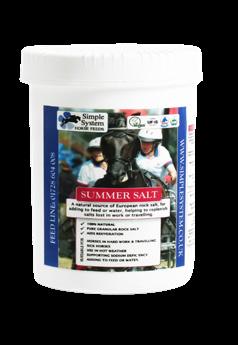
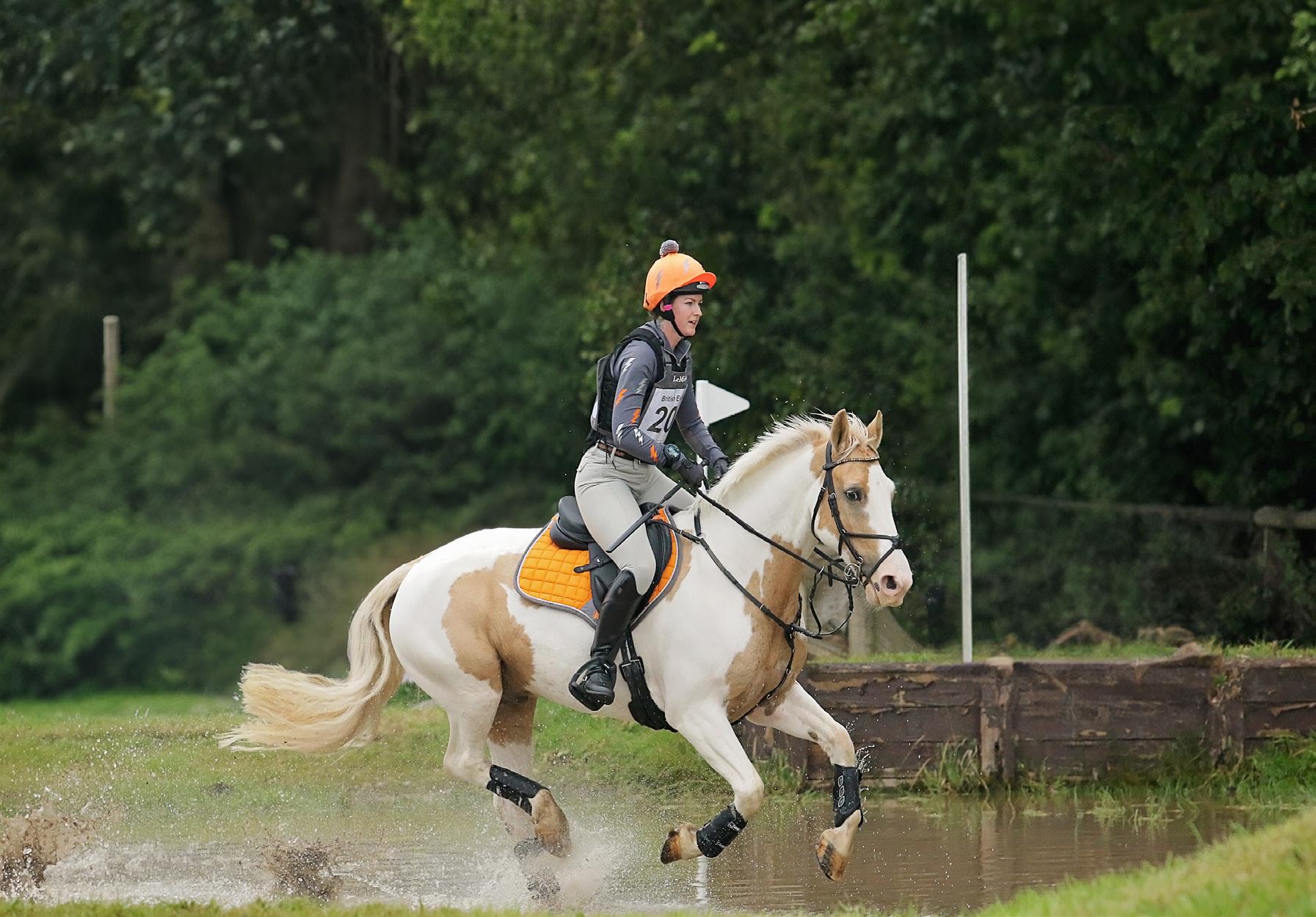
With the competition season in full swing you may be looking for ways to improve your horse’s performance. Offering a Target Feed may just be the ticket...
Target Feeding is the practice of offering a forage feed directly before work. As the name suggests, offering a feed in the moments before you get on board provides targeted energy to fuel the work that is required - allowing them to stay focused and comfortable. Feeding in this way also helps to line and protect the stomach against acid splash - a common cause of squamous ulcers.
There are many competition and leisure horses who don’t drink enough when they are away from home. By offering a soaked forage pellet as part of your Target Feed you are also improving your horse’s hydration.
What about the ‘Rule of Feeding’? Many of us were taught that our horses needed a period of rest before exercise if they had eaten a traditional hard feed. This is still the case if a starchy or cereal based feed is given.

‘‘Mr Quinn has a Target Feed before each phase. What a difference it has made’’
It does not apply with any of our Simple System feeds. This is because our feeds are based on the horse’s natural diet - forage. If you think back to when horses were free roaming, prior to being domesticated, they would have fled danger at a moment’s notice. If a horse had to wait an hour or so for the grass to go down first they would have most likely been predated to extinction.
Back to Target Feeding... Many customers have excellent results when Target Feeding, reporting greater energy levels, improved stamina and better focus.
Most horses can be Target Fed with their existing Simple System feeds, although for those wanting a ‘one bag’ option, Simply Complete is a convenient choice. For an extra energy boost try adding Red Bag Grass Pellets - they offer high energy levels likened to spring grazing.
Mr Quinn (pictured) enjoys a target feed of Blue Bag Grass Pellets, Lucie®Nuts and Build & Shine before each phase. He also has Simple Balance +® for his forage balancer.
Claire Pascoe Simple System CustomerThe more we look, the more we find ulcers in horses. They are being increasingly diagnosed across all horse populations (including leisure horses) likely due to greater awareness of the signs and symptoms. Overall, more horses now seem to have ulcers than don’t.
Ulcers are painful for the horse, can impact on their handlers or riders as they react to that pain, and may even reflect our failing to provide a calm and healthy environment. That’s not to say all owners of horses with ulcers are to blame - but it really ought to trigger all of us to think more about how we can better care for our horse’s needs. Ulcers should not be inevitable or acceptable.
Horses are sociable grazers, gradually moving around their range in groups, grazing and walking at the same time. If we isolate them from their own kind, restrict their range or limit their ability to eat for 16 hours a day, various levels of stress are created. Add inappropriate food and we can only wonder that ulcers are not even more prevalent. The right food can make a huge difference, but environmental factors will also have a significant impact on a successful outcome.
Acid is pretty much constantly generated in the horse’s stomach. It will build up to potentially damaging levels when the horse is not eating enough food to “mop it up”. Some food will actually increase the amount of acid in the stomach. Starch and sugar can be turned to acid by the action of certain microbes. Stress, environmental or due to pain, for instance, leads to extra acid being produced and will also damage the mucus secretions that protect the lower part of the stomach. Some or all of these will make a horse increasingly prone to developing ulcers.

Work, especially cantering, galloping and jumping, will cause the abdominal contents to put pressure on the stomach, forcing acid on to the sensitive upper part of the organ. Ulcers ensue.
There are plenty of things we can do to help combat ulcers:
• Allow horses as much time at grass as possible, with the company they need.
• Avoid starchy or sweetened feed, sticking with the best quality forages.
• Do not withhold feed, especially when they are worked - Target Feeding is good practice so long as it is with forage not cereal based feeds.
• Maintain a calm atmosphere and sympathetic training.
Ulcers are not an inevitable result of domesticating horses but rather an unintended consequence which can be remedied with a little more attention to the horse’s actual needs as a horse.
For comprehensive feeding advice, contact our Feed Line team on 01728 604 008.
Q. What is the best feed for ulcer prone horses? A. Lucerne (also known as alfalfa)
To learn more turn the page
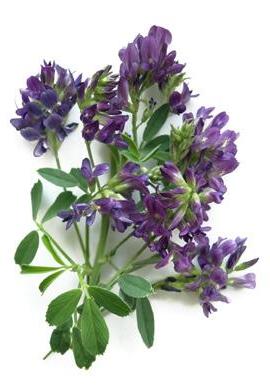
Lucerne is an amazing forage, known in different languages as ‘Prince of Feeds’ and ‘Best of the Best’. Lucerne has been grown for horses for around 5,000 years so has stood the test of time. It works really well for horses with ulcers for many reasons...
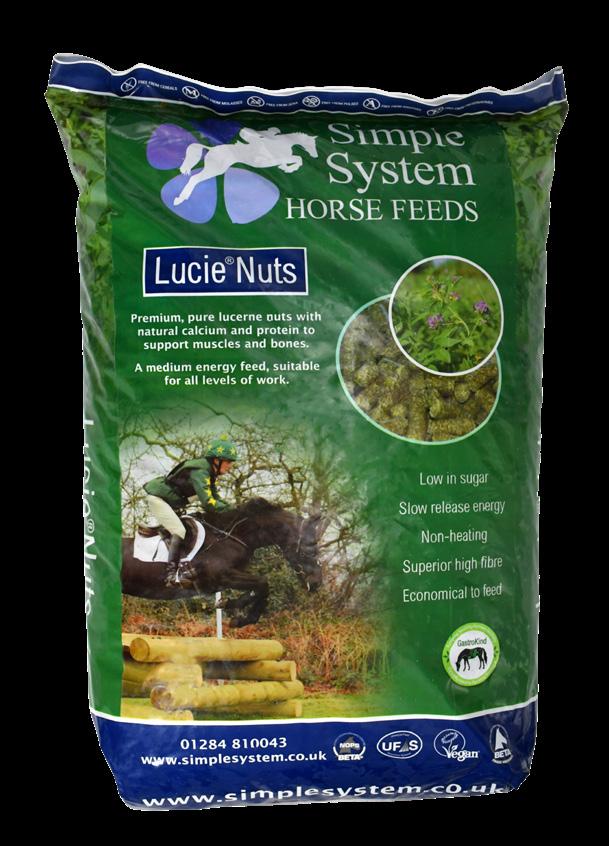
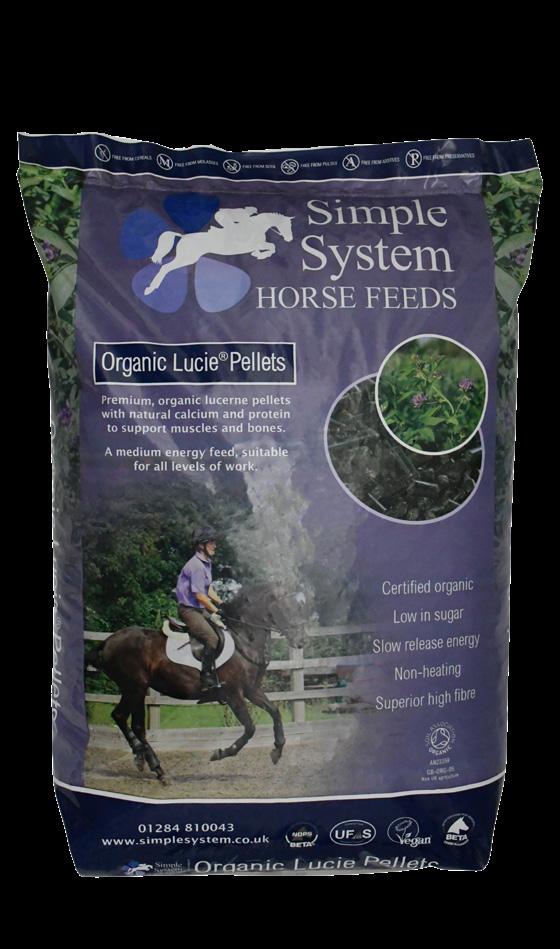
• It has better levels of calcium than any other forage, which helps against acid.
• Its proteins, which continue into the hindgut, effectively help buffer acid throughout the gut.

Its natural gums help soothe the gut lining.
Lucerne grown specifically for horses in the UK and Europe is naturally low in sugar and starch.
• Its fibre supports gut microbes as it is easily fermented by them.
a free diet plan scan the code


Soaked lucerne pellets, like Lucie®Nuts and Organic Lucie®Pellets, are soft and easily digested.

Lucerne chop/chaff, such as Lucie®Chop or Build & Shine, encourages chewing and additional saliva generation. Saliva actively neutralises acid, so anything to increase chewing is beneficial, provided the horse has good dentition.

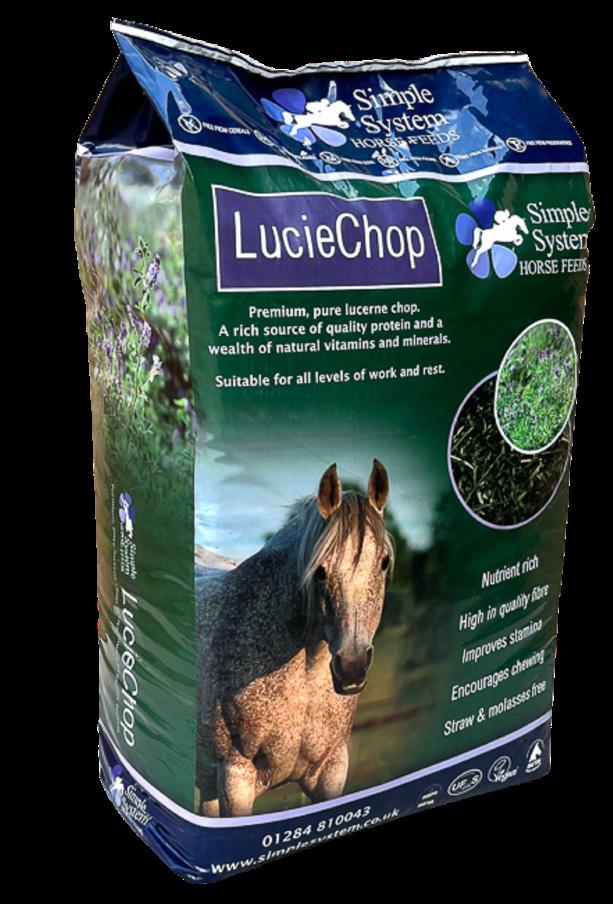
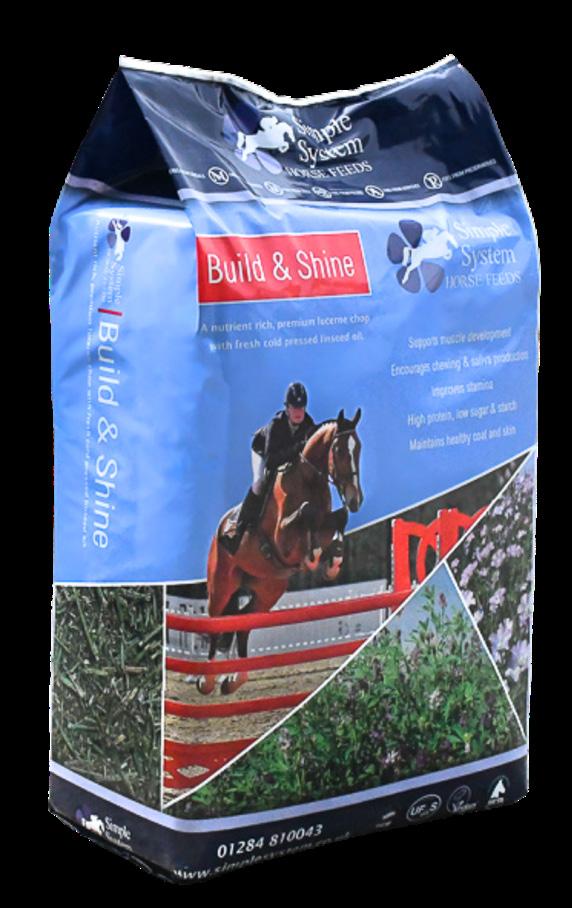

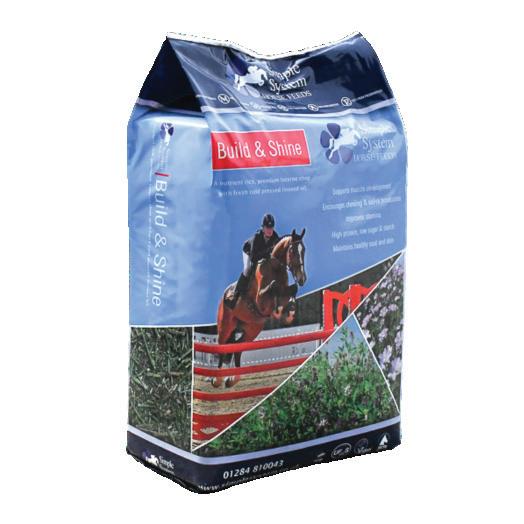

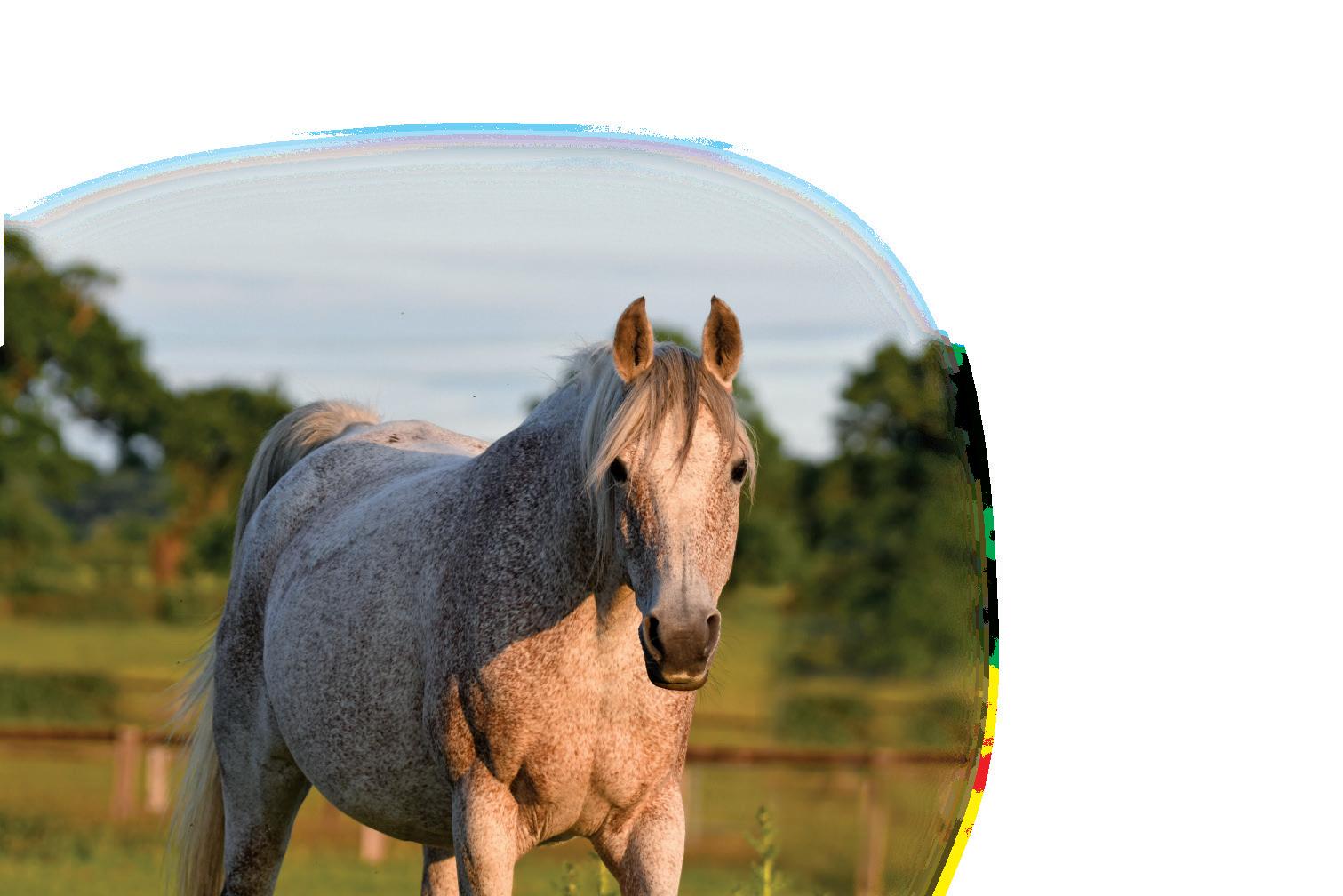

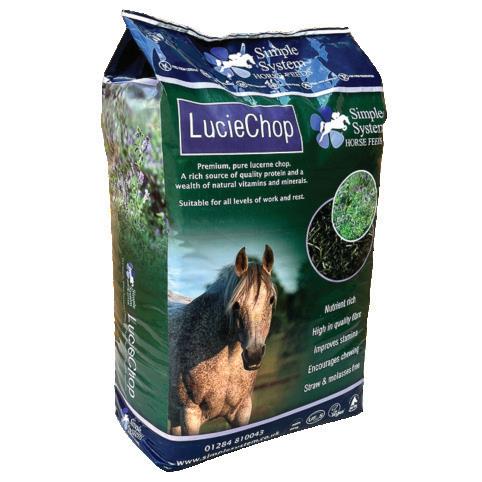

There are many scenarios in which you may be considering feeding a direct replacement for hay or haylage...
Youngsters... If your seemingly healthy youngster starts to lose condition it is quite possibly due to them experiencing dental changes. As highlighted in the chart to the left, young horses undergo such changes between the ages of 3 and 5. During this age range, the adult teeth erupt, dislodging the first teeth. These ‘baby teeth’ or ‘caps’ can make chewing very uncomfortable, especially long fibre forages like hay and grazing that is close to the ground. A soaked hay replacer will be far easier for them to manage and will help them maintain/regain condition. NB For any dramatic changes in condition you should always consult your vet.
Elderly dentally challenged horses... Dental issues in elderly horses are extremely common and often the main cause of weight loss. The deterioration or loss of teeth can make it difficult to chew long fibre such as hay, haylage and grass.
You may notice that your horse is having difficulty chewing forage if they begin quidding or you observe long length fibre in their droppings. Horses should have formed, moist, shiny faecal balls that form a nice pile when passed. This often isn’t the case when a horse becomes dentally challenged. Keep an eye on your horse’s droppings. If they are producing less, if they are small and hard or more watery then this can be a sign that it is time to use a hay replacer.
It is also worth noting that poor dentition is not just a problem for older equines. We are finding that diastemas are increasingly being diagnosed in horses of any age.
Weather... The British weather is increasingly unpredictable. We have just come out of an extremely wet winter. Many horses have been stabled for longer than usual. Over recent years there have been frequent occasions when hay/haylage is in short supply. Using a hay replacer can help to make the usual hay ration last longer or bridge a gap if supplies are running low.
The weather can also dictate the quality of hay produced. This can be crucial if your horse is a poor doer. If your hay simply isn’t good enough then you may find that feeding a partial hay replacer is beneficial.
Variety... Offering a partial hay replacer alongside the usual hay/haylage ration is a great way to keep your horse interested and encourage movement especially when stabled for longer periods. Place the tubs in different places around the stable or field. This is beneficial for all horses and ponies, but may be particularly useful for those with limited appetites or fussy feeders where offering a variety of forage may help to increase their overall intake. Using a different forage type can provide further variety stillLucie® Fibre Cubes are an ideal option.
Feeding insufficient amounts of forage increases the risk of digestive issues including colic. Hay replacers need to be fed in hay replacing quantities. For example if you wish to replace 6 kg of hay you will need to use 6 kg dry weight of hay replacer.
Like all dietary changes a hay replacer should be introduced gradually into the ration over the period of a week. Once a hay replacer has been gradually introduced it is appropriate to leave larger amounts to be grazed upon.
HayCare® is the most popular hay replacer, offering nutrition levels close to that of high fibre, low sugar hay. It is quick soaking, making it convenient and easy to feed. Use 2.5 parts of water for each part HayCare® .

I feed HayCare® to all horses as they come into my surgery. I also recommend HayCare for...
• Older equines who have smooth/senile cheek teeth and are finding it hard to chew hay.
• Those with multiple diastemas.
• Horses/ponies with severe PCD (peripheral cemental defects) as it has very low starch content.
• Post dental surgery.
• Increasing water intake on colder days (my pony who lives out is hugely grateful for this) and post competition / pre-journey home when horses can be reluctant to drink.
• I also recommend it to horses that come into a stable and gorge hay / get choke.
Dr Melissa Emson BVSc BAEDT MRCVS
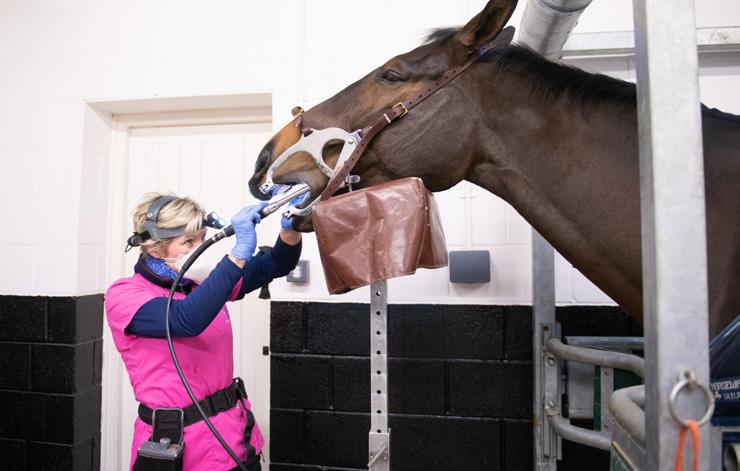
With an estimated 726,000 horses in the UK*, horse pastures must add up to a considerable acreage. Many will be permanent pasture which is an excellent sink for carbon. So many people have a negative notion of horses and their owners when it comes to land management, but we have a wonderful opportunity to make the most of the positive contribution horses can make to the environment.
The all too familiar sight of horses in overgrazed, uninspiring pens bordered by temporary and ill-maintained fencing is not going to win us friends, but appropriately managed horse pasture can be a haven for wildlife and biodiversity.
We need to be liberal in our view of what plants we want with our grass – unless it is poisonous, and if horses will eat it at some point, we want it! So-called weeds are often deep rooting and will help improve drainage by breaking up hard layers of soil. They may produce flowers that attract many flying insects – pollinators that we now know to be so important.
Well-managed grazing allows for the pasture to be rested with the grass and other plants having suffcient time to grow tall. Tall grass and plants have more fibre and less sugar than short, stressed grass. There is more herbage which will last the horses longer and while they are on this paddock, the one they came off is regenerating.
Over-grazing happens when the horses are still on the pasture when most of the herbage is grazed down and they are starting to eat the re-growth. Bare patches may establish, and the ground will soon become poached when it rains.
The more herbage you see above ground, the more there is below ground. Roots will reach down, fixing carbon in the soil and accessing minerals which may be depleted near the surface. One acre of well-managed pasture each day produces enough oxygen for more than 60 people and each year, will sequester over 400kg of carbon.
To start managing the grass better, you may need to keep the horses off the land – or confine them to a small sacrificial area with hay – until there is a good growth of tall grass. Don’t be tempted to turn out as soon as growth starts in the spring. Wait until June if needs be, but you will be rewarded with a lot more grass, with a lot more fibre and less sugar. Gradually you will have more and more grass, need less and less bought in feed and have healthier horses.
The land will not stay productive if you rob it of nutrients so make good use of the droppings your horse leaves. Ideally, with a good rotation, leave them be for the dung beetles to do their amazing work! Harrowing when the horses move on is also a good option if you feel the dung beetles are not (yet) up to the task. If you poo pick, stack the muck in a tidy heap and when it has had 6-12 months to rot, put it back as natural fertiliser – you are only returning what you took away.
There is far more that can be done to make our horse paddocks more nature friendly as well as healthier for the horses, but this at least is a start! We have such an opportunity as horse carers to make a real difference to the environment, we must not squander it.
TIP... Simple System’s Natural Grazing Mix is ideal for adding diversity to your pasture.

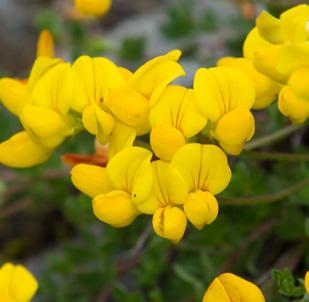
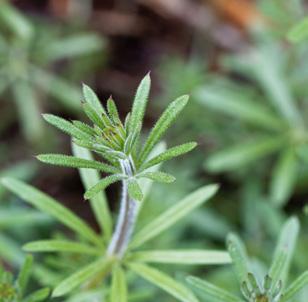

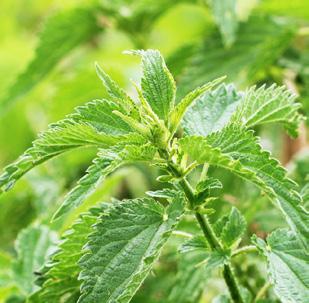
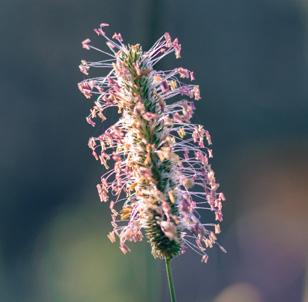
BIRDSFOOT TREFOIL
Beneficial for the horse’s ‘good gut bugs’ this hardy plant is widespread in the UK and thrives amongst short grass in chalky soil.
CLEAVERS | A hedgerow plant commonly known as ‘sticky weed’ or ‘goose grass’. Cleavers are a natural diuretic and are known to support the lymphatic system.
GORSE | Also known as Furze or Whin. Despite its needlelike prickles, many horses enjoy eating gorse. It has a pleasant coconut scent and is packed with protein.
NETTLES | A plant favoured by the Red Admiral butterfly and our horses. Nettles can help to support urinary function and the immune system.
TIMOTHY GRASS | This distinctive grass can grow over 1m tall. It has excellent nutritional value and features in several Simple System feeds, including HayCare.
HORSE FEEDS
Jane van Lennep BSc., MSc., BHSI(SM)., NPSD Director of Nutrition | info@simplesystem.co.uk
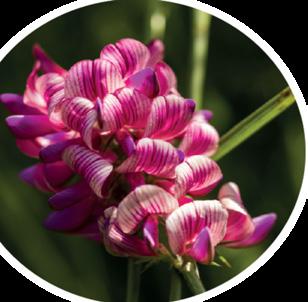
SAINFOIN | A Simple System key ingredient this legume is great for digestion and can aid the absorption of protein thanks to it’s unique condensed tannins.
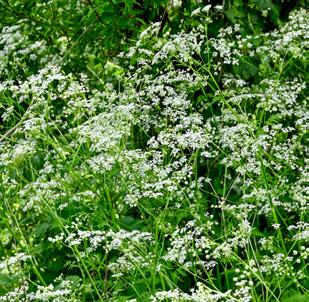

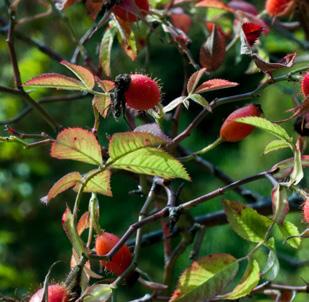
COW PARSLEY | A tasty and nutritious plant for horses. Be sure not to confuse with poisionous hemlock.

Scan to learn more
WILD DOG ROSE (Rosa canina) The rosehips from this common hedgerow plant are rich in antioxidants, providing natural joint support.
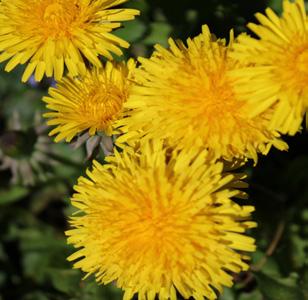

DANDELIONS | Excellent for soil structure and often the first to flower attracting pollinators. Dandelions are nutrient rich and can aid the horse’s gut microbes.
SOW THISTLE | Horses enjoy a variety of thistles. The sow thistle has flowers similar to dandelions and is a favourite of horses. It has antiinflammatory properties.
Simple System For free feeding advice please contact our Feed Line 01728 604 008 info@simplesystem.co.uk


Shanti has been brought up on a diet of Lucie®Nuts, Timothy Chop and Instant Linseed.


What were your reasons for deciding to breed your own foal? In 2021, Fudge didn’t feel completely sound under saddle. The vet investigated and she required a period of box rest and a long, slow rehabilitation plan. It was this that made me consider breeding my next riding partner. I thought it would be so rewarding to bring up a homebred youngster and decided that this could be the right time.
How did you go about choosing the ideal stallion? I follow ‘Ashlea Stud’ which is local to me. I went to meet the stallion I was keen to use and to ask Ashley at the stud for advice. Copilot is a homozygous tobiano piebald KWPN Sports horse. He is out of Wendy, by K3 Noir. He has fantastic conformation and breeding; he moves beautifully and has a lovely temperament. I decided that Copilot was definitely going to be the daddy! Did you have to do anything differently before Fudge was covered? Prior to being covered, Fudge was on her usual Simple System diet and exercise routine. She was in excellent condition and a picture of health. The process started by having the vet do pre-stud checks – an internal check over and swab. Fudge then went to the stud, where she was covered in hand each day she was in season. Fudge was scanned at home by the vet a couple of weeks later. She scanned empty, so she went back for a second visit, which was successful.
How did you manage Fudge once she was confirmed in-foal? Once Fudge had the ‘heartbeat scan’ I carried on as usual, hacking out and walking in hand regularly. Our hacks were mainly at my local forest and from home - nothing too strenuous, just enough to keep her fit and healthy, as per our usual routine.
Breeding your own foal for the first-time can be as daunting as it can be rewarding.
Simple System Customer, Jane McDonough, shares her experience.
Fudge was due to foal at the end of May 2023. Our last ride was in the February. From then on, we walked out in hand. Fudge’s favourite thing was to walk from the house up to the rough heather track where she could have a bite of heather and the prickly whin bush. I think it’s called ‘gorse’ in England, but in Scotland, it is known as ‘whin’. Fudge carefully picked new shoots and flowers off the prickly bush and I started to tie branches in her stable which she would strip overnight. In years past, local farmers fed whin to their cattle and sheep as it is packed with nutrients.
What dietary changes did you make in the last 3 months of pregnancy? At this point the foal was growing rapidly. Fudge’s feed amounts were increased greatly - keeping her in good shape and also to feed the growing foal. The Simple System Feed Line also suggested switching Fudge’s usual balancer to Lunar Eclipse.
How did foaling go? At 327 days Fudge’s udder had small clear droplets on the end. I knew that foaling was approaching. I began checking the cameras every 2 hours through the night and on 27th May at 329 days, the foal made an appearance. I’d checked the camera at 1am and no sign of anything. My alarm went off at 3am and as I looked at the camera ‘OMG…. There was a foal!’. I ran round to the stable to find a foal behind the door. Fudge had delivered on her own.
Fudge was very tense, snorting at the foal (a filly!) as she was trying to stand. The foal was up on her feet by 3.30am and had passed the myconium (first poo). Fudge wouldn’t let the foal anywhere near her to latch on to take her first drink of milk and the all important colostrum. It was stressful at this point and veterinary help was needed.
When the vet arrived he sedated Fudge, and expressed some milk into a lamb feeding bottle and we fed the foal. She soon latched on after that- thank goodness!
After watching back the camera footage, Fudge gave birth at 2.20 am, she was up on her feet 20 minutes later and then she cleaned the foal all over. She passed the afterbirth around 30 minutes after foaling, just before I checked the camera at 3am.
The vet called by again, 48 hours post partum. He gave Fudge and her foal a check over. Fudge had an oedema which was right along her belly and up to her udder, which is quite common post-foaling. She was given medication to make her more comfortable and it was then that Fudge and foal moved up to the stable in the paddock, where they could go outside.
How much did you feed whilst Fudge was nursing? Fudge was fed her usual feeds but in much greater quantities. She had 1.5kg of feed (dry weight before soaking) split into 3 meals, for the first 3 months after foaling. This was in addition to her usual grazing and hay.
How did you come to decide the foal’s name? I had a huge list of names! I wanted her name to be meaningful. I liked ‘Kaida’ which means ‘little dragon’ and also ‘Shanti.’ ‘Om Shanti’ means peace in mind, peace in body and peace in spirit. I decided to name the foal ‘Shanti’ as I already have one snorty Welsh dragon in the family, so thought I would go down the more ‘peaceful’ route!
Would you breed again?
Erm no! I don’t think so. Shanti was bred to be my next riding partner. I’m currently enjoying the experience of bringing up my own youngster.
Find these words
Antioxidants
Balancer
Broodmare
Chop
Diversity
Electrolytes
Environment
Eventing
Feed
Fibre
Forage
Grass
Meadow
MetaSlim
Mud
Nutrition
Pasture
Make a Match
Can you work out which statement matches which number?
1. The minimum temperature (C) for good grass growth
2. The age at which sycamore trees start to produce seeds
3. The minimum temperature (C) at which grass can grow
4. The maximum temperature (C) for grass roots to grow
5. The maximum temperature (C) for grass shoots to grow
6. The age that oak trees start to produce acorns

7. The mimimum temperature (C) for parasitic worm larvae to be active on pasture




We’ve teamed up with to give you the chance to WIN a 3 month supply of their most popular bedding - BedSoft Bio.
But that’s not all... we’ll also be giving away an expert nutritional consultation and a 3 month supply of a Simple System ‘Plus Range’ balancer which includes; Calm Balance + ® , MalleMash ® , MetaSlim ® , Simple Balance +® and Veteran Balance + ®


For your chance to WIN simply scan the code or visit www.simplesystemhorsefeeds.co.uk/competitions/bedsoft.asp
available at www.simplesystem.co.uk
‘Blaze has been fed a Simple System diet for the last few years and the change in her behaviour is fantastic!
She had a healthy foal last summer who was “grown” entirely on Simple System feed and is also now fed on Simple System post weaning.
I believe Blaze’s positive change is down to her much more natural diet!’
Tanya Skelding, Simple System Customer‘Veteran Balance +® has ticked all the boxes for me, and for Tally. Full of natural goodness that has been carefully put together. This shows through Tally’s skin and coat.’
Nikki Clark, Simple System Customer


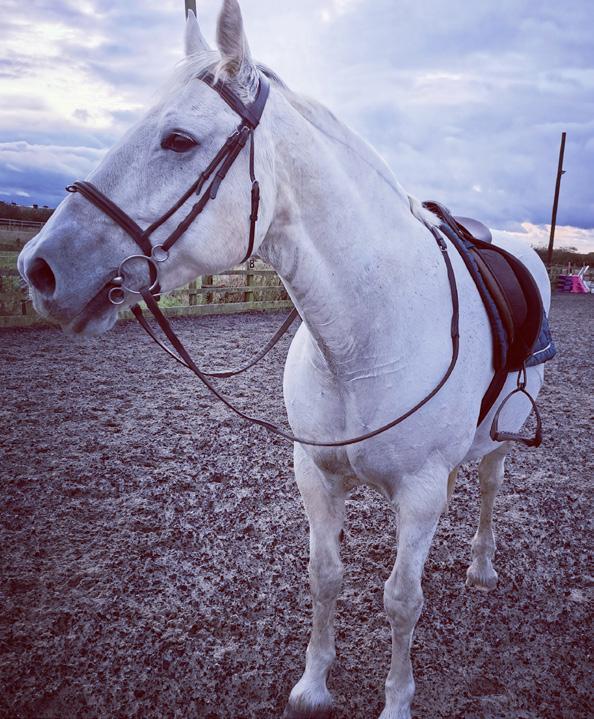
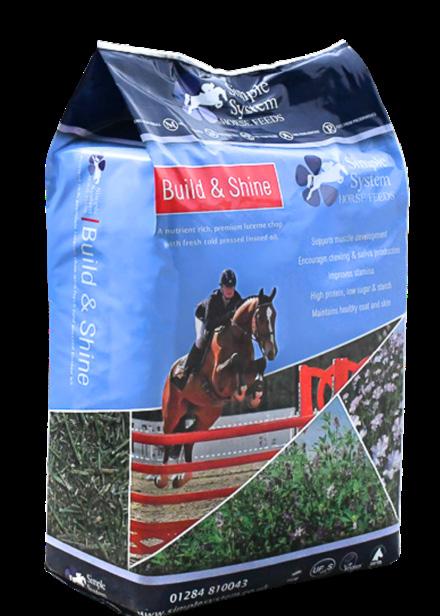
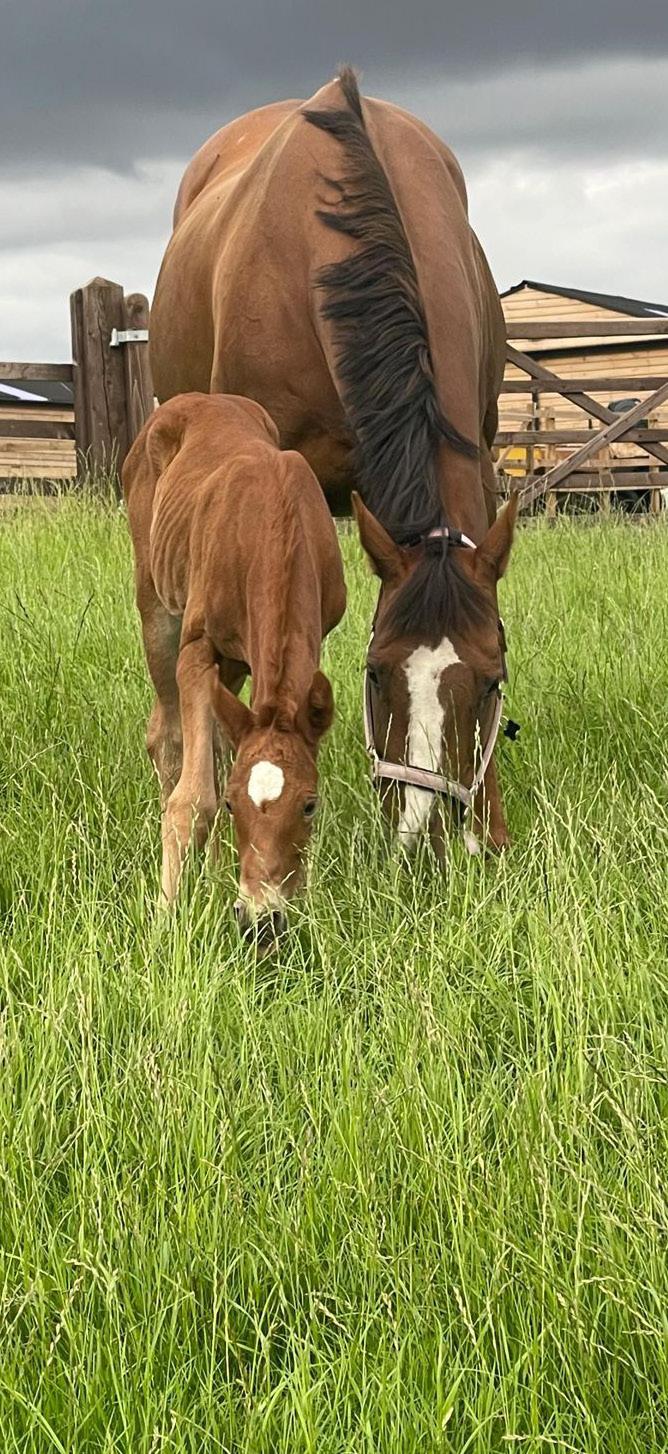
Add your story to our website gallery for a chance to feature in our next issue!
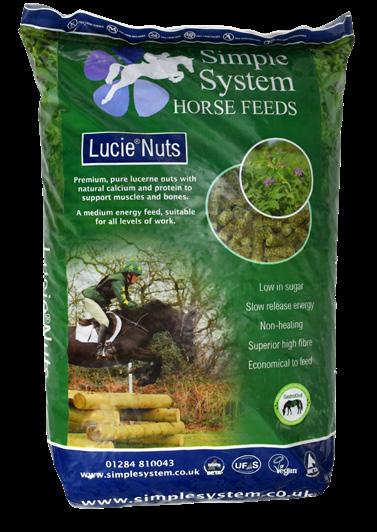
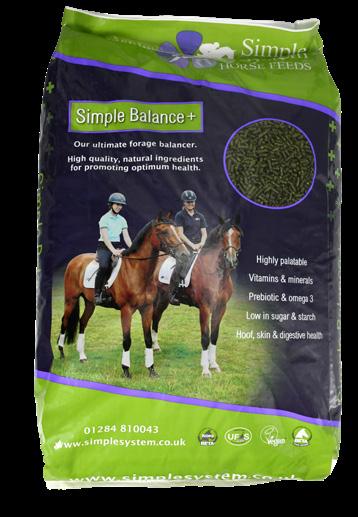
Visit www.simplesystem.co.uk and click the ‘Testimonials’ Tab
Horses lose salt in their sweat. In fact, a horse’s sweat is saltier than their blood, so these salts, called electrolytes, need to be replaced.
The minerals that come under the general heading of electrolytes include sodium, potassium, magnesium and calcium. Many diets are low in all of these, but a forage diet only lacks sodium - the others are in plentiful supply in a balanced forage diet. Sodium comes as sodium chloride, or common salt. So, your forage fed horse needs only a top-up of sodium.
At home you can easily place a Simple System Salt Lick Tub in the field or stable. When away at shows or events, carrying a 10kg tub around is not really practical. Instead, you can pack Summer Salt into the lorry. The 2kg tub
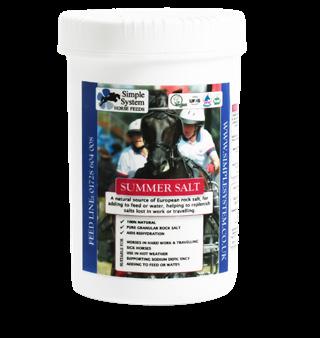
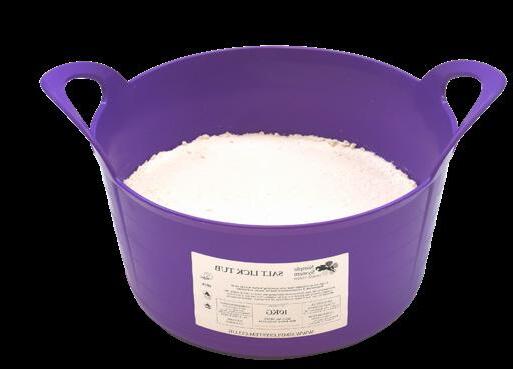
Salted water, especially if it is not too cold, can help to encourage a horse to drink. A standard stable bucket holds 3 gallons of water and will require 1.5 measures (45g) of Summer Salt. Remember to always offer plain water alongside.
It is good practise to offer a Target Feed directly before work (see page 18). Offering a feed directly after work, so long as it is forage, will aid recovery by replacing the other electrolytes. Feeding soaked forage pellets will also help to replace lost hydration - ideal for the warm summer days. Simple Balance +® is a great ‘one bag’ option as it is very quick soaking and is highly palatable.
